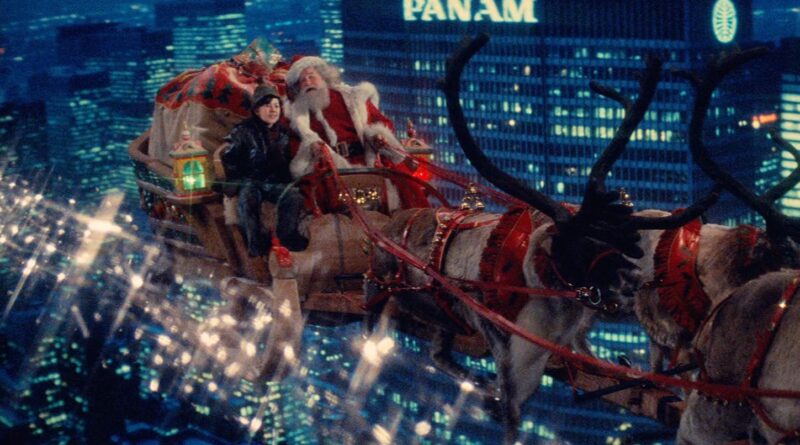Santa Claus: The Movie (1985)
Santa Claus: The Movie aims to be a heartwarming Christmas classic, but it’s more like a lump of coal in my stocking. The plot is unfocused. The characters aren’t developed very well. All it has in its favor are special effects and set designs, most of which show considerable skill and do indeed entice the audience into gawking at the screen. If you’re going to invest $50 million to make a movie look good – as producer Alexander Salkind reportedly did, along with his son Ilya and Pierre Spengler – why not make sure the movie is telling a good story? All evidence points to the fact that the three of them took that extra step when backing Richard Donner’s Superman. The end result was terrifically entertaining. This time around, it’s as if they decided not to bother.
It gets off to a promising start. Like the Rankin/Bass TV special Santa Claus Is Comin’ to Town, the first act creates a story for how the Christmas icon we know as Santa Claus comes into being. It happened centuries ago, when elves from the North Pole travel into an unnamed northern European country during a particularly nasty winter storm and magically rescue a kindly bearded toymaker (David Huddleston) and his wife (Judy Cornwell) from freezing to death in their sled, along with their two reindeer. The toymaker, named Claus, has made an annual end-of-year tradition of trekking from village to village and giving gifts to children; once taken to the elves’ toy factory, a briefly-seen elf played by Burgess Meredith explains that Claus was prophesied to become immortal and carry on his gift-giving tradition for all time, and for all the world’s children. Hence the addition of “Santa” to his name.
Even at this point in the story, the only point that’s at least halfway thought out, there are issues. When Santa is first shown the toy factory – utterly charming with its wooden carvings, bright colors, and cheerful choreography of the elves as they busily make toys – he never seems to be in awe, nor is he overcome by wonder; it comes off more like a state of shock, an almost trancelike episode of confusion. What’s worse, even with his occasional ho-ho-hoing laugh, he never seems to overcome his shock, not even after a montage sequence with a superimposed image of an hourglass showing the passage of centuries. Wouldn’t he have gotten used to it after that amount of time? But I’m getting ahead of the story. The aforementioned prophecy is mentioned only in passing; never once does Meredith’s wizened elf elaborate on it.
When the film flash-forwards to the present, it loses its way completely. That’s when three entirely different stories vie for the same space, only to become hopelessly entangled into a narrative mess. In one, Santa befriends Joe, a homeless adolescent boy from New York City (Christian Fitzpatrick); Santa allows Joe to accompany him one Christmas Eve as he flies his sleigh and eight reindeer over and around the skyscrapers of Manhattan. That’s pretty much the extent of Joe’s development. The rest is just padding, like the fact that he’s periodically fed by a sympathetic girl named Cornelia (Carrie Kei Heim). She lives in the lap of luxury but feels no love whatsoever from her family or nanny. Just as poorly developed a character, she too will become one of Santa’s friends. Curious that neither she nor Joe seem to age, even though they’re introduced three or four Christmases earlier. The passage of time is one of the film’s several problems.
In another story, an elf named Patch (Dudley Moore) flees the North Pole when his attempt at modernizing the toy factory with a mass-production machine goes horribly wrong. Hoping to prove himself to Santa, he transports himself to New York and, armed with an idea for magical lollipops that make eaters float, partners himself with the wealthy, loathsome, unscrupulous toy tycoon B.Z. (John Lithgow). He’s desperate to save his reputation after several of his toys are shown to be very unsafe. Moore is directed to be the film’s comedy relief, especially in regards to his naïveté about life outside the North Pole. Unfortunately, most of the jokes written for him aren’t all that funny, and his constant replacing of the word “self” with “elf” quickly gets old. As for Lithgow, he could have been an effective villain had he not been directed as an overblown, 1930s-style stereotype of the greedy capitalist – always smoking a cigar, laughing fiendishly, wearing designer suits and fur coats, reacting with horror at the word “free.”
And then there’s the story of Santa himself, who begins to feel obsolete in today’s world. Only now does he see that, even at Christmastime, not everyone cares about each other. Worse still, his legend is believed in less and less. It’s a compelling idea, but the way the filmmakers handle it, it comes off as an afterthought, a last-ditch effort at adding some amount of depth to the story. Too little, too late; most of the filmmakers’ energy went towards shots of Santa flying around in his sleigh, always leaving behind a trail of brilliant, twinkling stars. Yes, they’re dazzling, but they’re also superficial. Santa Claus: The Movie needed substance as well as style. What was needed most, I believe, was a greater examination of the title character; there needed to be a progression, a period of maturity, a sense that he had to acclimate to his annual responsibilities.




